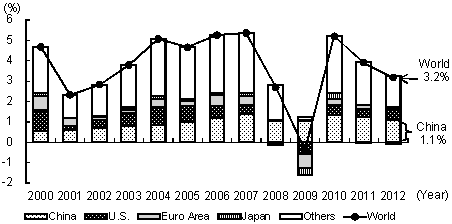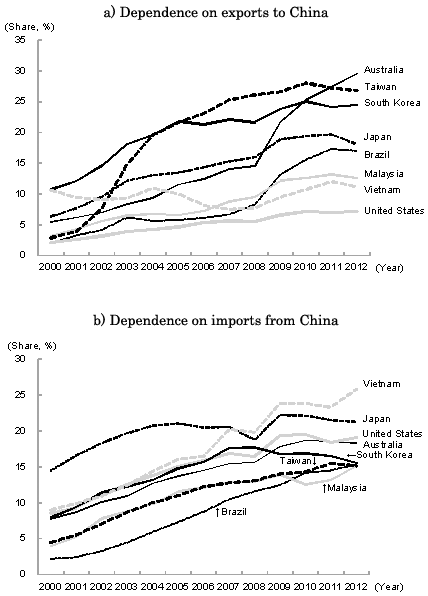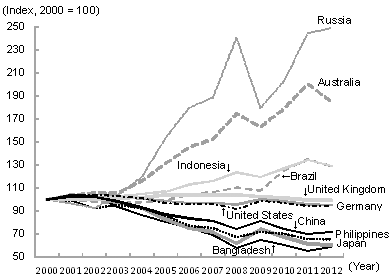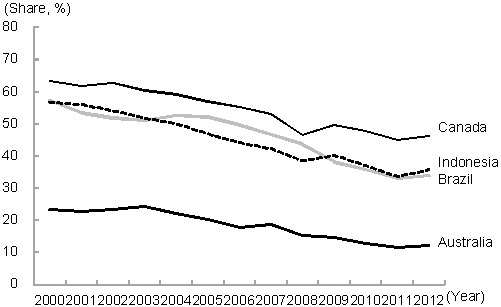China achieved high growth at an average annual rate of 9.8% from 1979 to 2012, a period when the country shifted its policies to reform and opening up. China's gross domestic product (GDP) increased from $1.5 trillion in 2002 to $8.2 trillion—more than 50% of the United States' GDP—in 2012, partly backed by the appreciation of the renminbi. In the process, in 2010, China surpassed Japan to become the second largest economy in the world after the United States. In addition, China's contribution to the growth rate of the world economy has exceeded that of the United States since 2001, and, in 2012, it reached 1.1%, which is equivalent to approximately one-third of overall growth (3.2%) (Figure 1). In this way, China has been increasing its presence in the world economy.

Contribution of China in 2012: (1.1%) = (7.7%) × (14.1%)
Contribution of the U.S. in 2012: (0.5%) = (2.8%) × (19.6%)
The rise of China is having an impact on the world economy mainly through foreign trade and direct investment. In analyzing this, attention should be paid not only to the income effect as a result of expanding demand, but also to the price effect, which results in a transfer of real income and an industrial reorganization on a global scale through changes in the relative prices of labor-intensive products such as textiles, technology-intensive products such as machinery, and primary commodities such as oil.
Income effect: Foreign countries' increasing dependence on trade with China
China's share of world exports between 2000 and 2012 rose substantially, from 3.9% to 11.1%, while its share of world imports also climbed significantly, from 3.4% to 9.8%. China is now the world's largest exporter and the second largest importer after the United States, widening its gap with Japan.
Against this backdrop, most countries have become increasingly dependent on trade with China with respect to both exports and imports (Figure 2). Particularly, for many Asian economies such as Japan, South Korea, Taiwan, Malaysia, and Vietnam, China is now their largest trading partner. As China's economic growth rate is expected to exceed the world average by a large margin (although it will start to decline), countries' dependence on trade with China is likely to continue to rise in the future.

Price effect: Competitive and complementary relationships with China will decide the outcome
Through the process of opening up its economy, China has expanded its exports by specializing in labor-intensive products by bringing in foreign capital and mobilizing surplus labor in the rural areas. As a result, the global supply of labor-intensive products has increased as has the global demand for technology-intensive products and primary commodities. Such changes in the supply and demand relationship have worked to lower the prices of labor-intensive products relative to those of technology-intensive products and primary commodities, resulting in deterioration of the terms of trade (the relative price of its exports to imports) for China and improvement of those for the rest of the world. Other countries have also been able to benefit from China's economic development through the transfer of real income associated with these changes.
However, both winners and losers are among those affected by this price effect. For countries in complementary relationships with China (i.e., those importing labor-intensive products and exporting technology-intensive products or primary commodities, a trade pattern opposite to that of China), the deterioration of China's terms of trade translates to the improvement of theirs. Typical examples include advanced industrial nations and resource-exporting countries. In contrast, the terms of trade for countries competing with China (i.e., those exporting labor-intensive products and importing technology-intensive products or primary commodities, like China) would worsen on the heels of the deterioration of China's terms of trade. Typical examples include the Association of Southeast Asian Nations (ASEAN) countries and other newly industrialized countries. However, improvement in terms of trade for developed countries and resource-exporting countries is partially offset by rises in the prices of primary commodities and technology-intensive products, respectively.
In fact, looking at countries' terms of trade from 2000 to 2012, those of China declined by 28.2% while those for resource-exporting countries such as Russia, Australia, Indonesia, and Brazil improved substantially by 148.9%, 84.8%, 29.2%, and 28.9%, respectively (Figure 3). Meanwhile, those for countries exporting labor-intensive products such as Bangladesh and the Philippines deteriorated significantly. For advanced industrial nations such as the United States, Germany, and the United Kingdom, their figures remained largely unchanged, reflecting the fact that their terms of trade vis-à-vis China improved but deteriorated vis-à-vis resource-exporting countries. Japan's terms of trade declined overall, as those vis-à-vis resource-exporting countries deteriorated substantially although those vis-à-vis China improved.

Recently, however, subtle changes have been occurring in this price effect. In China, a labor shortage has arisen due to the decline in the working-age population and the depletion of surplus labor in the rural areas. Reflecting this, its economic growth rate has been declining, and its comparative advantage has been shifting from labor-intensive products to technology-intensive products. As a result, the relative price of labor-intensive products to technology-intensive products and primary commodities is expected to rise. Contrary to the past, while this change in relative prices will be favorable to newly industrializing countries that export labor-intensive products, it will hurt advanced industrial countries that export technology-intensive products, as well as resource-exporting countries that export primary commodities.
Impact on foreign countries' industrial structure
Changes in relative prices and, in turn, in the terms of trade of countries associated with the rise of China have resulted in real income transfers and industrial realignment on a global scale by inducing resource allocation.
First, in advanced industrial countries, the production of numerous labor-intensive products has been transferred to China through direct investment, etc. Unless new industries arise to replace them, a hollowing out of industry will occur.
Meanwhile, in resource-exporting countries, the primary commodities' share of exports has risen, while in contrast, industrial products' share of exports has declined, following a surge in the prices of primary commodities. In fact, between 2000 and 2012, the ratio of industrial products to exports declined from 23.2% to 12.2% in Australia, from 63.3% to 46.2% in Canada, from 57.4% to 33.8% in Brazil, and from 56.7% to 35.6% in Indonesia (Figure 4). This is very similar to the "Dutch disease"; namely, a country that has newly discovered natural resources will lose its international competitiveness in areas other than resources, such as the manufacturing industry, as a result of currency appreciation due to the larger trade surplus driven by the export of natural resources.

However, the phenomenon in which the rise of China leads to Dutch disease in certain countries is at a turning point in the wake of China's move to begin transferring its labor-intensive and other declining industries overseas while upgrading its industry in order to deal with its labor shortage. After World War II, many industries were transferred in stages from Japan to newly industrialized economies in Asia, ASEAN countries, and China. This is known as the "flying geese pattern," and the cross-border industrial realignment that has recently begun in China is following this pattern. For many resource-exporting countries and newly industrializing countries, getting in the line of this flying geese pattern as a post-China investment destination and an export platform will become a window of opportunity to accelerate their industrialization and recover from the Dutch disease.
The original text in Japanese was posted on November 6, 2013.


